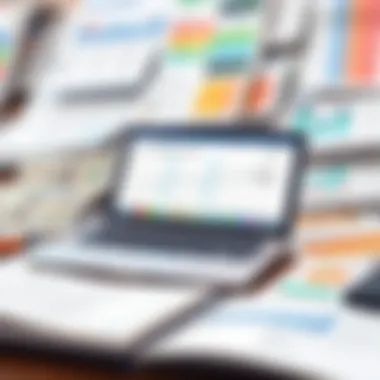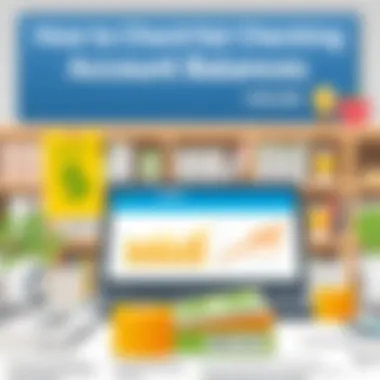How to Check Your Checking Account Balance Online Easily


Intro
In today’s fast-paced world, keeping tabs on your checking account balance has never been easier thanks to the rise of digital banking. Checking your balance online can ease the stress of managing your finances, helping you see where you stand and plan effectively. Whether you’re trying to avoid overdraft fees or just keeping an eye on your spending, knowing how to access this information is essential.
This guide dives into the various methods you can use to check your checking account balance online. We’ll walk you through utilizing banking apps, websites, and some smart strategies to ensure your online financial management is secure and efficient. As you navigate these waters, understanding the steps, security measures, and troubleshooting options will empower you to take control of your money from the comfort of your home or even on the go.
Now let’s embark on this journey of financial insights and uncover the best ways to track your account balance effectively.
Understanding Your Checking Account
Understanding your checking account is essential in today’s fast-paced world, especially when managing finances. A checking account is not just a place to keep your money; it’s the foundation of your financial activities. This account allows you to deposit funds, withdraw cash, pay bills, and make purchases effortlessly. With many people leaning towards digital banking, grasping the intricacies of checking accounts is vital for making informed decisions about your money.
Definition of Checking Accounts
A checking account is a type of bank account that enables you to easily access your funds for daily transactions. These accounts generally offer features such as debit cards, which allow you to make purchases directly. You can also write checks or initiate electronic transfers. Unlike savings accounts, which typically earn interest but limit the number of withdrawals, checking accounts provide a more fluid experience, letting you manage your finances without concern over withdrawal limits. The checks, debit cards, and online banking facilities make them a go-to option for people to manage their cash flow.
Importance of Monitoring Your Balance
Monitoring your balance is not merely a recommendation, but rather a necessity for effective financial management. Here’s why keeping an eye on your checking account balance is crucial:
- Avoiding Overdraft Fees: Picture this: You try to withdraw $100, but your account has just $50. Not only does it bounce, but your bank slaps you with an overdraft fee. Keeping track of your balance helps you avoid embarrassing situations and unnecessary costs.
- Budgeting: Knowing how much you have in your checking account is fundamental for effective budgeting. A clear understanding of your funds allows you to allocate money for bills, groceries, leisure, and savings without overspending.
- Fraud Prevention: Regularly checking your balance can help spot unauthorized transactions quickly. If you see something fishy, you can report it to your bank, potentially saving yourself from significant losses.
- Peace of Mind: There’s a certain comfort in knowing exactly where your finances stand at any given moment. Instead of worrying about account discrepancies or insufficient funds, being proactive can alleviate anxiety over your money.
Remember: Having a solid grasp of your checking account not only aids in personal finance but also positions you to make more strategic financial decisions in the future.
In summary, understanding your checking account’s role is paramount and monitoring your balance plays a significant part in that understanding. The more engaged you are with your account, the more empowered you become in managing your finances.
Why Access Your Balance Online?
In today's fast-paced mondo, keeping tabs on your finances shouldn't feel like a chore. Accessing your checking account balance online is not just a luxury; it's a necessity that aligns perfectly with the modern lifestyle. The digital age has transformed financial management, offering benefits that previous generations could only dream of. Understanding why accessing your balance online is crucial lays the foundation for making informed decisions about your money.
Convenience and Accessibility
Gone are the days when one had to trek all the way to a bank branch, wait in long queues, and endure the bureaucratic process just to check their balance. Now, with a few clicks or taps, customers can access their financial information from the comfort of their homes or on the go.
- Anytime Access: Whether it's the crack of dawn or late at night, your checking account is just a login away.
- Multiple Devices: Prefer checking your balance on your smartphone? Or maybe your tablet? Online banking services offer a seamless experience across various devices. You choose what fits your schedule!
- Instant Transfers: Need to shuffle funds between accounts? Online access enables quick transactions, avoiding costly overdraft fees.
The beauty of this convenience can't be overstated. It fosters financial responsibility, allowing you to manage your money in real-time. All the hassle is stripped away, giving you more control and freedom with your finances.
Real-time Updates
One of the most significant advantages of checking your balance online is receiving real-time updates. Knowing your financial status instantly can help in several ways:
- Financial Planning: Keeping your balance in check allows for better budgeting and helps you track your spending habits. This awareness can prevent overspending and lead to better savings.
- Transaction Tracking: Online access often includes detailed transaction histories. This real-time view helps you recognize and dispute any discrepancies right away, meaning you're not left in the dark over surprises.
- Immediate Awareness of Events: Sudden expenses or unexpected deposits? With real-time access, you're quickly informed of changes that could affect your financial picture.
"Knowledge is power, and instant access to your finances empowers you to respond promptly to whatever life throws your way."
In short, the ability to check your balance online offers not just peace of mind but also the agility needed in today’s financial landscape. Overall, being informed helps you make better decisions, ensuring that your financial health remains solid as a rock.


Methods to Check Your Balance
In today’s fast-paced world, keeping tabs on your checking account balance is vital. It serves as a financial lifeline, ensuring you stay informed about your funds and avoid unpleasant surprises. With an array of methods available, understanding the options at your disposal can help you make informed choices that best suit your lifestyle.
Using Online Banking Services
These days, online banking has become a household staple. The ease of accessing your balance with just a few clicks is hard to surpass. Setting up online banking not only simplifies your financial management but also integrates various functionalities into one platform.
Setting Up Online Banking
Getting started with online banking is often as easy as pie. By providing your email address, account numbers, and some personal information, you can create your online banking profile. This method is particularly popular due to its simplicity and efficiency, allowing users real-time access to their financial data. When you set up online banking, you get a one-stop shop for all your financial needs. Key characteristics include:
- Convenience: You can check balances anytime, anywhere, without the need for a physical trip to the bank.
- Integrated Features: Besides balance checks, you can pay bills, transfer funds, and apply for loans all in one spot. The downside? While the benefits are plenty, you must remember to secure your information; otherwise, it might lead to headaches down the line.
Navigating the Online Banking Interface
Once you're in, navigating the online banking interface can be like taking a stroll in the park—once you know the path. Most banks have user-friendly designs that allow for easy access to your account balance. You’ll find features like balance summaries and transaction histories readily available. Of great importance is the search functionality. It lets you find transactions quickly with just a few keystrokes. Some interfaces even enable you to categorize your spending so that you know where every penny is going. While the online interface is a breeze for many, others may struggle with varying layouts across different banks. This inconsistency can sometimes lead to confusion.
Mobile Banking Apps
Mobile banking apps have taken the convenience of online banking and stuffed it into your pocket. With a simple tap on your smartphone, your account balance is just a few swipes away.
Downloading the Official App
A crucial first step for mobile banking is downloading your bank's official app. This step is generally straightforward; navigate to the App Store or Google Play, search for your bank, and install.
The biggest advantage is that it provides a seamless way to access your financial info on the go. Plus, many apps offer features like budgeting tools and spending alerts to help you manage your money better.
However, familiarity with your bank’s app might be necessary to utilize its full potential, and there are instances of subpar user experiences in some applications.
Logging Into the App
Once the app is downloaded, you’ll need to log in. This usually involves entering your username and password, akin to accessing online banking. The great thing about most banking apps is the ability to remember your log-in details, saving you time during future visits. Many apps even offer biometric logins such as fingerprint or facial recognition, enhancing user convenience while keeping security a top priority. But remember, if you're not careful, forgetting your password could lead to frustration, or worse, being locked out.
Automated Phone Services
For individuals uncomfortable with technology, automated phone services provide a convenient alternative. This method allows you to check your balance with just a phone call.
How to Use Automated Services
Using these services is usually as simple as dialing the designated number and following voice prompts. You'll typically need to verify your identity, often through account numbers or other personal information, before being told your balance. An obvious upside of this option is the accessibility it provides, especially for those less familiar with online banking methods. However, depending on your bank, waiting time could vary, and the complexity of navigating automated menus might deter some users.
Tips for Security
Security should always be a top priority, especially when dealing with financial information over the phone. Ensure you're accessing legitimate numbers—double-check your bank's website for the correct details.
Also, avoid sharing personal information with anyone, even during calls. Keeping your details close to the vest helps protect against potential threats.
Third-Party Financial Apps
Increasingly, third-party financial apps have emerged as popular choices for tracking bank balances. These apps offer different functionalities and can consolidate multiple accounts in a single place.
Evaluating Third-Party Applications


Before jumping into using a third-party app, do your homework. Check reviews, look for features that suit your needs, and ensure the app aligns with your bank's services. The appeal of these apps lies in their comprehensive financial management options that often extend beyond just checking balances. However, beware of potential fees that some apps may require. Also, while many apps boast robust security features, relying on a third party can introduce new risks.
Ensuring Data Security
Data security is crucial, particularly with third-party applications that access your banking info. Look for apps that use encryption for data, two-factor authentication, and adhere to industry standards. Always read the privacy policies, which can provide insight into how your information will be used. Understanding these aspects can elevate your confidence when using third-party applications. They can offer unparalleled convenience when appropriately vetted but can come with their own set of risks.
Security Concerns
In an age where our lives revolve around digital technology, the importance of security concerns cannot be overstated. When accessing your checking account balance online, understanding security measures becomes essential. Not only does it protect your finances, it also shields your personal information from potential fraudsters. As someone navigating this digital space, being aware of potential threats and how to counter them is a crucial step towards maintaining control over your financial health.
Protecting Your Personal Information
Keeping your personal information safe is like locking the front door of your house. If you leave it open, anyone can walk right in. Always go for secure websites, which usually start with "https://". Before entering sensitive info, check for the little padlock symbol next to the web address. Additionally, avoid accessing your account on public Wi-Fi networks. Using such networks can be like inviting a thief over for brunch. Instead, stick to secure connections like your home Wi-Fi or your mobile data plans.
Another useful tip is to avoid sharing your information through unsecured channels, like email or text messages. Fraudsters can craft convincing messages to trick you into handing over personal data. Always verify the source before sharing anything. It's not just about you; several online thieves are just waiting for that slip-up, ready to take advantage of it.
Recognizing Phishing Attacks
Phishing attacks are more common than one might think. They often come disguised as emails or texts from seemingly trustworthy sources like your bank. The goal is simple: bait you into clicking a link that leads to a fake website designed to steal your credentials.
To identify a phishing attempt, keep an eye out for oddities. If the email address doesn't match the official one or if the message is riddled with spelling mistakes and grammatical errors, take a step back. Phishing messages are often urgent, pushing you to act quickly without thinking. Always err on the side of caution. If something feels fishy, it probably is. A good practice is to type the bank's website into your browser yourself rather than clicking on links.
Using Strong Passwords and Two-Factor Authentication
Think of your password as the key to your financial fortress. A weak password is like leaving a window open in said fortress; it invites uninvited guests. Always opt for strong, complex passwords that include a mix of letters, numbers, and symbols. Avoid obvious choices like birthdays or favorite sports teams.
Moreover, enable Two-Factor Authentication (2FA) wherever possible. It adds an extra layer of security by requiring a second form of identity verification—usually a text message sent to your phone or an authentication app. With 2FA, even if someone gets hold of your password, they still need that second piece of information to access your account.
In addition to these tactics, regularly updating your password can catch potential intruders off guard. Set a reminder to change it every few months. This small routine can immensely improve your account's security and keep you one step ahead of the bad actors lurking in the shadows of the internet.
Troubleshooting Common Issues
Forgotten Passwords and Account Lockouts
One of the most frequent roadblocks individuals face when trying to check their balance online is a lost or forgotten password. It’s annoying, but it happens to the best of us. Most banking websites and apps contain a straightforward way to reset your password. Typically, you would look for a ‘Forgot Password?’ link on the login page. Here's what to do:
- Click the ‘Forgot Password?’ link.
- Enter your registered email address or phone number.
- Follow the instructions emailed or texted to you to reset your password.
A word of caution: banking systems are designed to protect your information, so after a few failed attempts to log in, your account may become temporarily locked. This is a safety feature to prevent unauthorized access. If you find yourself locked out, patience and follow-through are key. Gather whatever identification and documentation your bank may require for verifying identity before reaching out to customer support or using alternative recovery options.
Technical Failures
Technical glitches can be a real pain when you're already in a rush to access your account. Whether it’s a website down for maintenance or an app update gone haywire, these disruptions can leave you feeling stranded. To prepare, always have a backup plan:
- Use Different Devices: Try accessing your account from a different computer or your smartphone.
- Switch Browsers: Sometimes, the browser you’re using might be causing the issue. Switching from Chrome to Edge, for example, can sometimes work miracles.
- Check for Updates: Ensure that your mobile app is up to date; sometimes, just a simple update can remedy many issues.
If the problem persists, it might be worthwhile to check your internet connection. This simple step can solve some of the most common frustrations. If you've done all that and you’re still facing problems, don’t hesitate to reach out via the bank's official social media channels. They're usually quite responsive.


Contacting Customer Support
When you find yourself out of your depth, contacting customer support can be your saving grace. But it's essential to do it in a methodical way to ensure the conversation flows smoothly:
- Prepare Your Info: Before dialing, have your account number and any relevant personal information at your fingertips. This will speed up the identification process.
- Be Clear and Concise: Explain your issue succinctly, mentioning any error messages you’ve received, as that can help the support staff provide faster solutions.
- Take Notes: Write down the name of the representative and any reference numbers given during the call. This could come in handy if you have to follow up later.
In a world where financial management is becoming increasingly digital, knowing how to troubleshoot these common issues reinforces not just your ability to access your checking account balance, but your overall financial health. Remember, while technology streamlines our banking processes, occasional hurdles are just another aspect of financial stewardship. By being prepared and knowing your options, you’ll navigate these bumps in the road with greater ease.
Maintaining Your Account Awareness
Understanding how to monitor your checking account isn't just about knowing your balance; it’s crucial for keeping track of your overall financial health. Regularly checking your balance and account activity ensures you stay on top of your finances, prevents overdraft fees, and helps you avoid surprise expenses. Furthermore, maintaining account awareness bolsters your ability to spot unauthorized transactions, which is increasingly important in a digital banking world.
A vigilant eye on your account minimizes the chances of falling victim to fraud and aids in making timely decisions about your spending. It's not just about knowing what you have left at the end of the month, but also about recognizing patterns in your spending and eventually shaping habits that contribute to your financial well-being.
Setting Alerts for Account Activity
Setting up alerts for account activity is a smart move that can keep you informed at all times. Most banks offer this feature, allowing you to receive notifications via text or email whenever certain transactions occur. These alert options might include balances dropping below a threshold you set, deposits that have been made, or even unusual activity that could signal fraud. Here are some key benefits and considerations:
- Proactive Oversight: Get real-time insights about your finances. No more waiting for monthly statements to figure out your spending patterns.
- Customized Notifications: Tailor alerts to suit your needs—whether it be transaction spending limits or notifications for recurring payments.
- Faster Response to Issues: Should you receive an alert for a transaction you did not authorize, you can act promptly. This swift action can often prevent further unauthorized activity.
Reviewing Regular Statement Notifications
Checking regular statement notifications is equally important. Many banking institutions send statements electronically on a monthly or bi-weekly basis. Taking the time to review these statements closely allows you to track your spending more accurately and spot discrepancies.
Here’s why reviewing your statements is essential:
- Identity Theft Detection: Regularly examining transactions can reveal unauthorized charges quickly. The sooner you notice something amiss, the better your chances of resolving the issue.
- Budget Management: By analyzing where your money goes each month, you can identify patterns and make adjustments if needed—like cutting back on dining out or impulse buys.
- Understanding Fees: Statements often itemize fees deducted from your account, which can help you understand where you might cut costs in the future.
To sum it up, being proactive about monitoring your checking account through alerts and regular statement reviews can make a world of difference. It paves the way for informed decision-making, fosters better spending habits, and ultimately supports a healthier financial life.
"An ounce of prevention is worth a pound of cure."
For those who wish to dig deeper into personal finance management, sources like Investopedia or NerdWallet offer a wealth of information on budgeting techniques and financial strategies.
Culmination
In today's digital age, being able to check your checking account balance online is nearly as essential as holding the account itself. Understanding how to navigate this online landscape offers numerous advantages, helping users manage their finances with ease and convenience. By embracing these digital tools and resources, individuals can monitor their spending habits and maintain effective budget management.
A major benefit to highlight is the real-time accessibility of account information, which empowers users to make informed decisions about their finances swiftly. Being able to track transactions on the go minimizes the risk of overdrafts and unexpected fees, paving the way for improved financial health. Furthermore, the ability to set up alerts for account activities enhances awareness of unusual transactions, which can be a red flag for potential fraud.
"With great power comes great responsibility."
From understanding how to utilize online banking systems to recognizing the need for enhanced security measures, monitoring one's checking account online fosters a culture of financial literacy. This article emphasizes not only the steps required to check account balances but also the implications of doing so securely and efficiently. It is vital to frequently revisit personal financial literacy, as it equips individuals to make smarter and more prudent financial choices as their life circumstances evolve.
By consistently engaging in practices that enhance financial knowledge and accountability, individuals empower themselves—taking charge of their finances rather than letting them control their lives. In summary, making online checking account management part of your routine can lead to a more secure and savvy approach towards financial wellness.
Summary of Key Points
- Checking your checking account balance online is convenient, providing real-time insights into your finances.
- Multiple methods exist for access, including banking websites, mobile apps, and automated services.
- Security is paramount; strong passwords and two-factor authentication are key.
- Familiarity with account monitoring can prevent fraud and support better financial decision-making.
Encouragement for Ongoing Financial Literacy
Embracing a mindset of continuous learning regarding personal finance can significantly enhance one’s overall financial health. It’s not just about knowing how to check what’s in the bank but also understanding how to allocate funds, save for future goals, and invest wisely. There are countless resources available online, such as financial planning websites, educational platforms, and community forums that cater to a variety of learning preferences.
By actively exploring financial literacy topics, individuals set a foundation for lifelong learning. For instance, platforms like Khan Academy offer free courses on personal finance, while forums like Reddit's Personal Finance allow for community engagement and peer support in navigating financial challenges.







